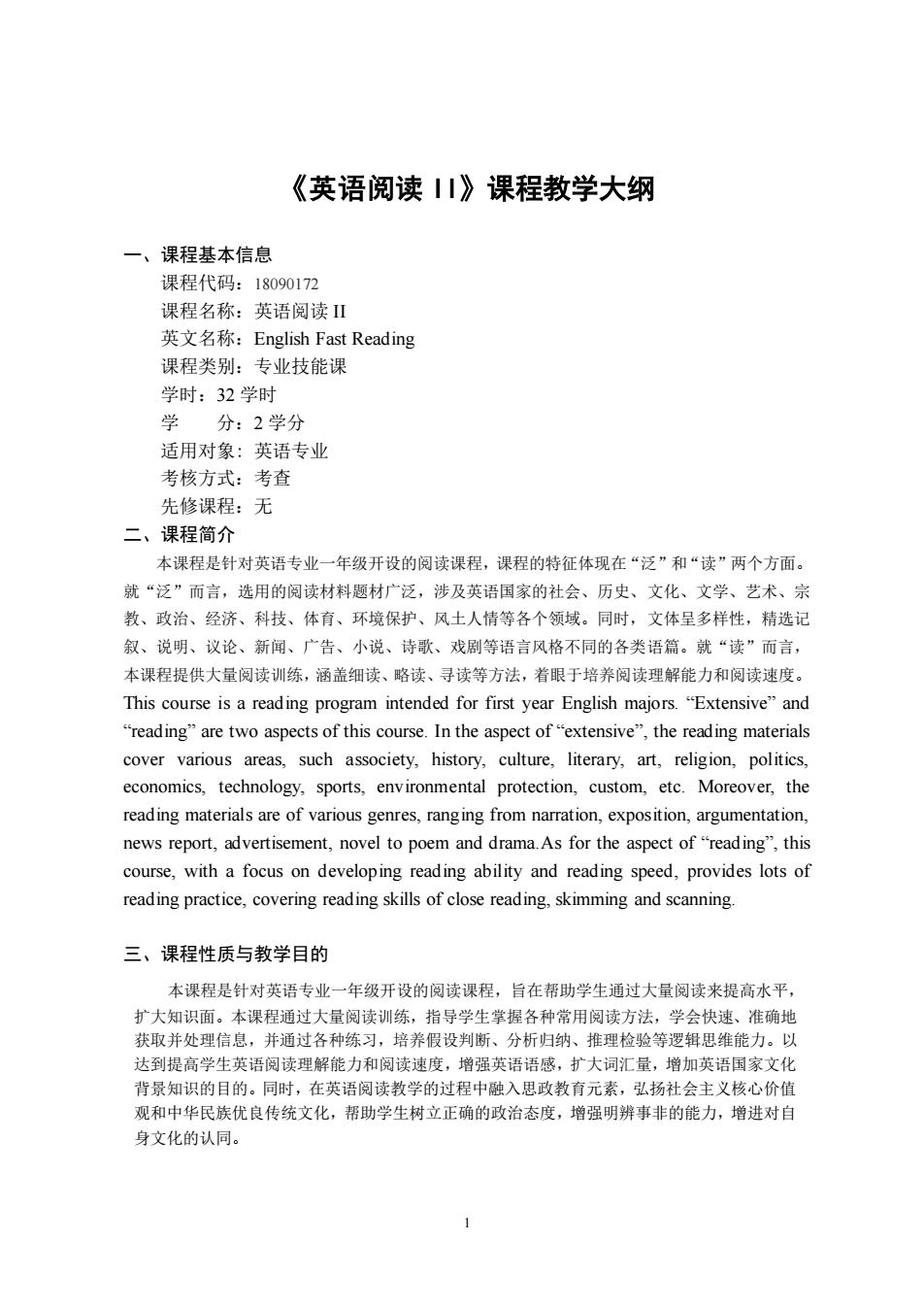
《英语阅读川》课程教学大纲 一、课程基本信息 课程代码:18090172 课程名称:英语阅读Ⅱ 英文名称:English Fast Reading 课程类别:专业技能课 学时:32学时 学 分:2学分 适用对象:英语专业 考核方式:考查 先修课程:无 二、课程简介 本课程是针对英语专业一年级开设的阅读课程,课程的特征体现在“泛”和“读”两个方面。 就“泛”而言,选用的阅读材料题材广泛,涉及英语国家的社会、历史、文化、文学、艺术、宗 教、政治、经济、科技、体有、环境保护、风土人情等各个领域。同时,文体呈多样性,精选记 叙、说明、议论、新闻、广告、小说、诗歌、戏剧等语言风格不同的各类语篇。就“读”而言, 本课程提供大量阅读训练,涵盖细读、略读、寻读等方法,着眼于培养阅读理解能力和阅读速度。 This course is a reading program intended for first year English majors."Extensive"and “reading”are two aspects of this course.In the aspect of“extensive”,the reading materials cover various areas,such associety,history,culture,literary,art,religion,politics economics.technology.sports.environmental protection.custom.etc.Moreover.the reading materials are of various genres,ranging from narration,exposition,argumentation, news report,advertisement,novel to poem and drama.As for the aspect of"reading".this course,with a focus on developing reading ability and reading speed,provides lots of reading practice,covering reading skills of close reading,skimming and scanning. 三、课程性质与教学目的 本课程是针对英语专业一年级开设的阅读课程,旨在帮助学生通过大量阅读来提高水平, 扩大知识面。本课程通过大量阅读训练,指导学生掌握各种常用阅读方法 学会快速、准确地 获取并处理信息,并通过各种练习,培养假设判断、分析归纳、推理检验等逻辑思维能力。月 达到提高学生英语阅读理解能力和阅读速度,增强英语语感,扩大词汇量,增加英语国家文化 背景知识的目的。同时,在英语阅读教学的过程中融入思政教育元素,弘扬社会主义核心价值 观和中华民族优良传统文化,帮助学生树立正确的政治态度,增强明辨事非的能力,增进对自 身文化的认同。 1
1 《英语阅读 II》课程教学大纲 一、课程基本信息 课程代码:18090172 课程名称:英语阅读 II 英文名称:English Fast Reading 课程类别:专业技能课 学时:32 学时 学 分:2 学分 适用对象: 英语专业 考核方式:考查 先修课程:无 二、课程简介 本课程是针对英语专业一年级开设的阅读课程,课程的特征体现在“泛”和“读”两个方面。 就“泛”而言,选用的阅读材料题材广泛,涉及英语国家的社会、历史、文化、文学、艺术、宗 教、政治、经济、科技、体育、环境保护、风土人情等各个领域。同时,文体呈多样性,精选记 叙、说明、议论、新闻、广告、小说、诗歌、戏剧等语言风格不同的各类语篇。就“读”而言, 本课程提供大量阅读训练,涵盖细读、略读、寻读等方法,着眼于培养阅读理解能力和阅读速度。 This course is a reading program intended for first year English majors. “Extensive” and “reading” are two aspects of this course. In the aspect of “extensive”, the reading materials cover various areas, such associety, history, culture, literary, art, religion, politics, economics, technology, sports, environmental protection, custom, etc. Moreover, the reading materials are of various genres, ranging from narration, exposition, argumentation, news report, advertisement, novel to poem and drama.As for the aspect of “reading”, this course, with a focus on developing reading ability and reading speed, provides lots of reading practice, covering reading skills of close reading, skimming and scanning. 三、课程性质与教学目的 本课程是针对英语专业一年级开设的阅读课程,旨在帮助学生通过大量阅读来提高水平, 扩大知识面。本课程通过大量阅读训练,指导学生掌握各种常用阅读方法,学会快速、准确地 获取并处理信息,并通过各种练习,培养假设判断、分析归纳、推理检验等逻辑思维能力。以 达到提高学生英语阅读理解能力和阅读速度,增强英语语感,扩大词汇量,增加英语国家文化 背景知识的目的。同时,在英语阅读教学的过程中融入思政教育元素,弘扬社会主义核心价值 观和中华民族优良传统文化,帮助学生树立正确的政治态度,增强明辨事非的能力,增进对自 身文化的认同
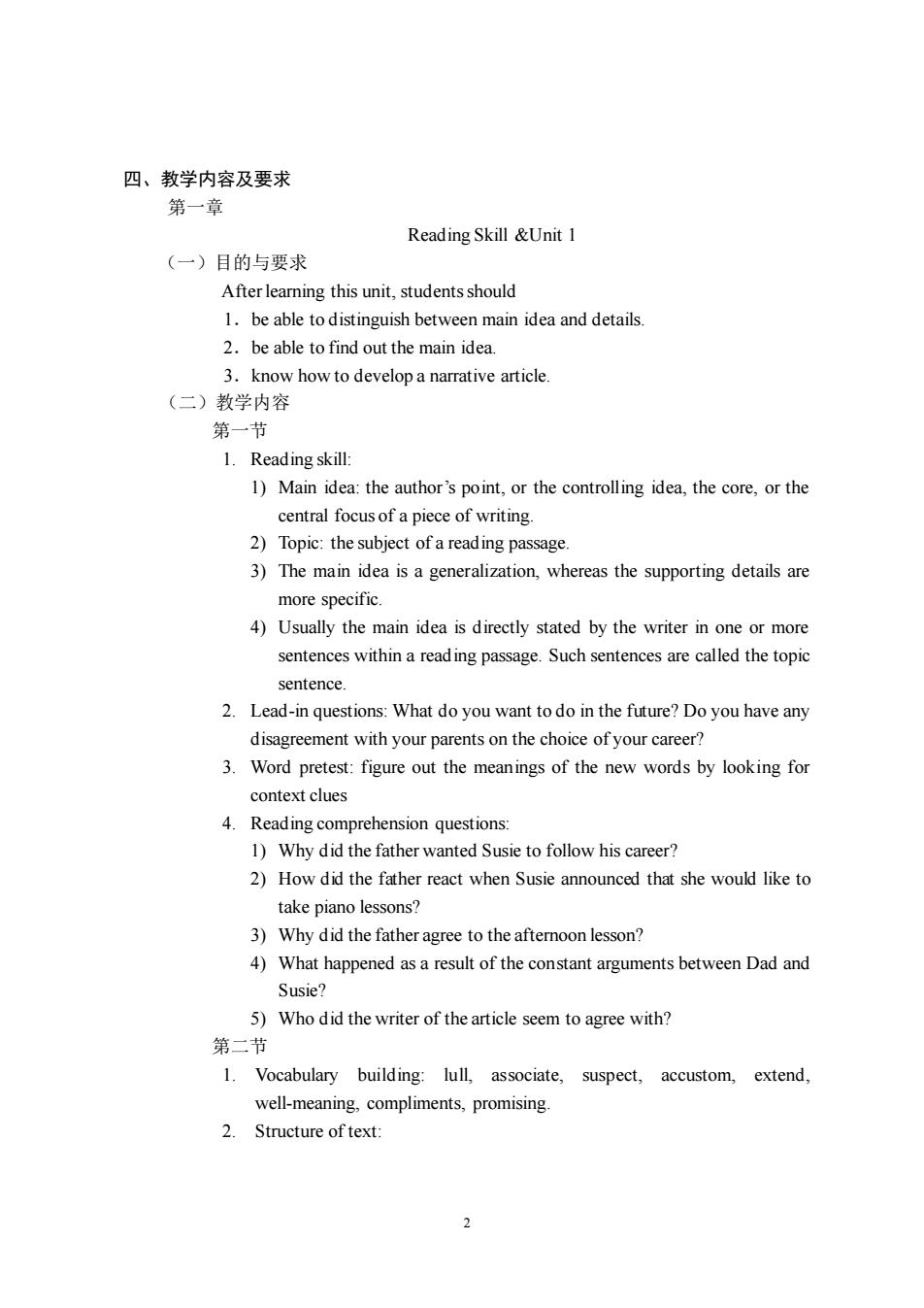
四、教学内容及要求 第一章 Reading Skill &Unit 1 (一)目的与要求 After learning this unit,students should 1.be able to distinguish between main idea and details. 2.be able to find out the main idea. 3.know how to develop a narrative article. (二)教学内容 第一节 1.Reading skill: 1)Main idea:the author's point,or the controlling idea,the core,or the central focus of a piece of writing. 2)Topic:the subject of a reading passage. 3)The main idea is a generalization,whereas the supporting details are more specific. 4)Usually the main idea is directly stated by the writer in one or more sentences within a reading passage.Such sentences are called the topic sentence. 2.Lead-in questions:What do you want to do in the future?Do you have any disagreement with your parents on the choice of your career? 3.Word pretest:figure out the meanings of the new words by looking for context clues 4.Reading comprehension questions: 1)Why did the father wanted Susie to follow his career? 2)How did the father react when Susie announced that she would like to take piano lessons? 3)Why did the father agree to the aftemoon lesson? 4)What happened as a result of the constant arguments between Dad and Susie? 5)Who did the writer of the article seem to agree with? 第二节 1.Vocabulary building:lull,associate,suspect,accustom,extend, well-meaning.compliments,promising 2.Structure oftext:
2 四、教学内容及要求 第一章 Reading Skill &Unit 1 (一)目的与要求 After learning this unit, students should 1.be able to distinguish between main idea and details. 2.be able to find out the main idea. 3.know how to develop a narrative article. (二)教学内容 第一节 1. Reading skill: 1) Main idea: the author’s point, or the controlling idea, the core, or the central focus of a piece of writing. 2) Topic: the subject of a reading passage. 3) The main idea is a generalization, whereas the supporting details are more specific. 4) Usually the main idea is directly stated by the writer in one or more sentences within a reading passage. Such sentences are called the topic sentence. 2. Lead-in questions: What do you want to do in the future? Do you have any disagreement with your parents on the choice of your career? 3. Word pretest: figure out the meanings of the new words by looking for context clues 4. Reading comprehension questions: 1) Why did the father wanted Susie to follow his career? 2) How did the father react when Susie announced that she would like to take piano lessons? 3) Why did the father agree to the afternoon lesson? 4) What happened as a result of the constant arguments between Dad and Susie? 5) Who did the writer of the article seem to agree with? 第二节 1. Vocabulary building: lull, associate, suspect, accustom, extend, well-meaning, compliments, promising. 2. Structure of text:
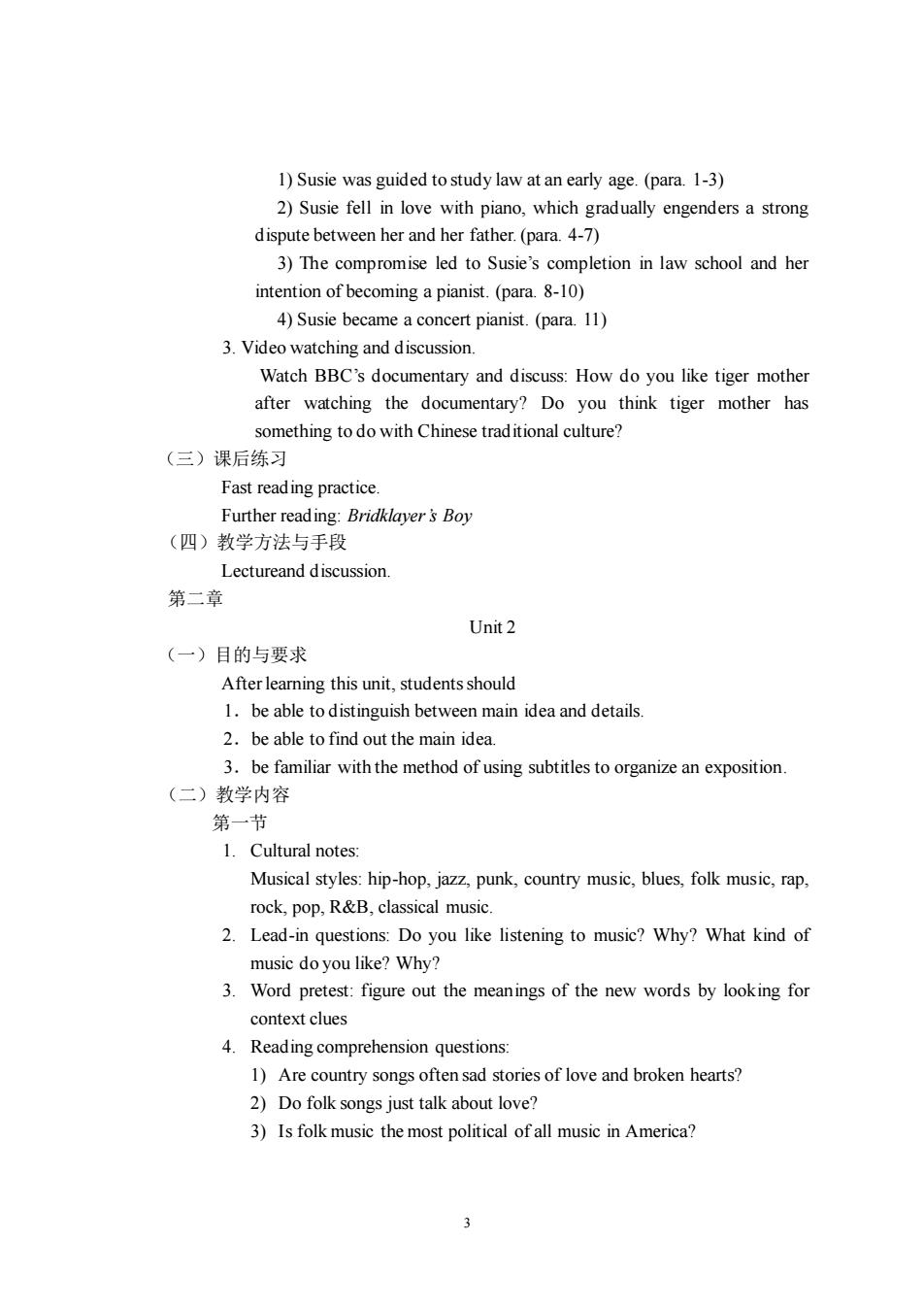
1)Susie was guided to study law at an early age.(para.1-3) 2)Susie fell in love with piano,which gradually engenders a strong dispute between her and her father.(para.4-7) 3)The compromise led to Susie's completion in law school and her intention of becoming a pianist.(para.8-10) 4)Susie became a concert pianist.(para.11) 3.Video watching and discussion. Watch BBC's documentary and discuss:How do you like tiger mother after watching the documentary?Do you think tiger mother has something to do with Chinese trad itional culture? (三)课后练习 Fast reading practice. Further reading:Bridklayers Boy (四)教学方法与手段 Lectureand discussion 第二章 Unit2 (一)目的与要求 After learning this unit,students should 1.be able to distinguish between main idea and details. 2.be able to find out the main idea. 3.be familiar with the method of using subtitles to organize an exposition. (二)教学内容 第一节 1.Cultural notes Musical styles:hip-hop,jazz punk,country music,blues,folk music,rap. rock,pop,RB,classical music. 2.Lead-in questions:Do you like listening to music?Why?What kind of music do you like?Why? 3.Word pretest:figure out the meanings of the new words by looking for context clues 4.Reading comprehension questions: 1)Are country songs often sad stories of love and broken hearts? 2)Do folk songs just talk about love? 3)Is folk music the most political ofall music in America? 3
3 1) Susie was guided to study law at an early age. (para. 1-3) 2) Susie fell in love with piano, which gradually engenders a strong dispute between her and her father. (para. 4-7) 3) The compromise led to Susie’s completion in law school and her intention of becoming a pianist. (para. 8-10) 4) Susie became a concert pianist. (para. 11) 3. Video watching and discussion. Watch BBC’s documentary and discuss: How do you like tiger mother after watching the documentary? Do you think tiger mother has something to do with Chinese traditional culture? (三)课后练习 Fast reading practice. Further reading: Bridklayer’s Boy (四)教学方法与手段 Lectureand discussion. 第二章 Unit 2 (一)目的与要求 After learning this unit, students should 1.be able to distinguish between main idea and details. 2.be able to find out the main idea. 3.be familiar with the method of using subtitles to organize an exposition. (二)教学内容 第一节 1. Cultural notes: Musical styles: hip-hop, jazz, punk, country music, blues, folk music, rap, rock, pop, R&B, classical music. 2. Lead-in questions: Do you like listening to music? Why? What kind of music do you like? Why? 3. Word pretest: figure out the meanings of the new words by looking for context clues 4. Reading comprehension questions: 1) Are country songs often sad stories of love and broken hearts? 2) Do folk songs just talk about love? 3) Is folk music the most political of all music in America?
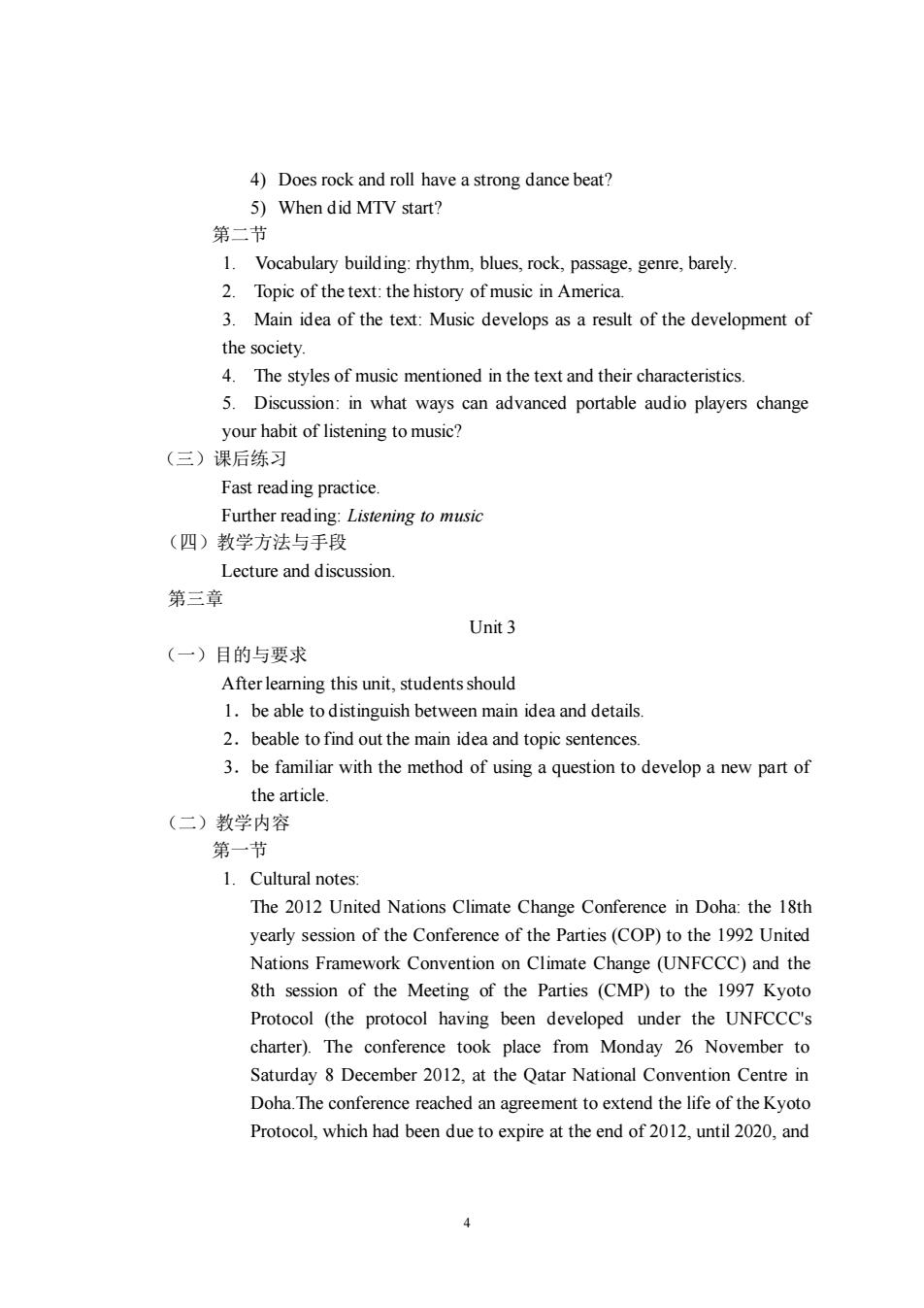
4)Does rock and roll have a strong dance beat? 5)When did MTV start? 第二节 1. Vocabulary building:rhythm,blues,rock,passage,genre,barely. 2.Topic of the text:the history of music in America. 3.Main idea of the text:Music develops as a result of the development of the society. 4.The styles of music mentioned in the text and their characteristics. 5.Discussion:in what ways can advanced portable audio players change your habit of listening to music? (三)课后练习 Fast reading practice. Further reading:Listening to music (四)教学方法与手段 Lecture and discussion 第三章 Unit3 (一)目的与要求 After leaming this unit,studentsshould 1.be able to distinguish between main idea and details. 2.beable to find out the main idea and topic sentences. 3.be familiar with the method of using a question to develop a new part of the article. (二)教学内容 第一节 1.Cultural notes The 2012 United Nations Climate Change Conference in Doha:the 18th yearly session of the Conference of the Parties(COP)to the 1992 United Nations Framework Convention on Climate Change (UNFCCC)and the 8th session of the Meeting of the Parties (CMP)to the 1997 Kyoto Protocol (the protocol having been developed under the UNFCCC's charter).The conference took place from Monday 26 November to Saturday 8 December 2012,at the Qatar National Convention Centre in Doha.The conference reached an agreement to extend the life of the Kyoto Protocol,which had been due to expire at the end of 2012,until 2020,and 4
4 4) Does rock and roll have a strong dance beat? 5) When did MTV start? 第二节 1. Vocabulary building: rhythm, blues, rock, passage, genre, barely. 2. Topic of the text: the history of music in America. 3. Main idea of the text: Music develops as a result of the development of the society. 4. The styles of music mentioned in the text and their characteristics. 5. Discussion: in what ways can advanced portable audio players change your habit of listening to music? (三)课后练习 Fast reading practice. Further reading: Listening to music (四)教学方法与手段 Lecture and discussion. 第三章 Unit 3 (一)目的与要求 After learning this unit, students should 1.be able to distinguish between main idea and details. 2.beable to find out the main idea and topic sentences. 3.be familiar with the method of using a question to develop a new part of the article. (二)教学内容 第一节 1. Cultural notes: The 2012 United Nations Climate Change Conference in Doha: the 18th yearly session of the Conference of the Parties (COP) to the 1992 United Nations Framework Convention on Climate Change (UNFCCC) and the 8th session of the Meeting of the Parties (CMP) to the 1997 Kyoto Protocol (the protocol having been developed under the UNFCCC's charter). The conference took place from Monday 26 November to Saturday 8 December 2012, at the Qatar National Convention Centre in Doha.The conference reached an agreement to extend the life of the Kyoto Protocol, which had been due to expire at the end of 2012, until 2020, and
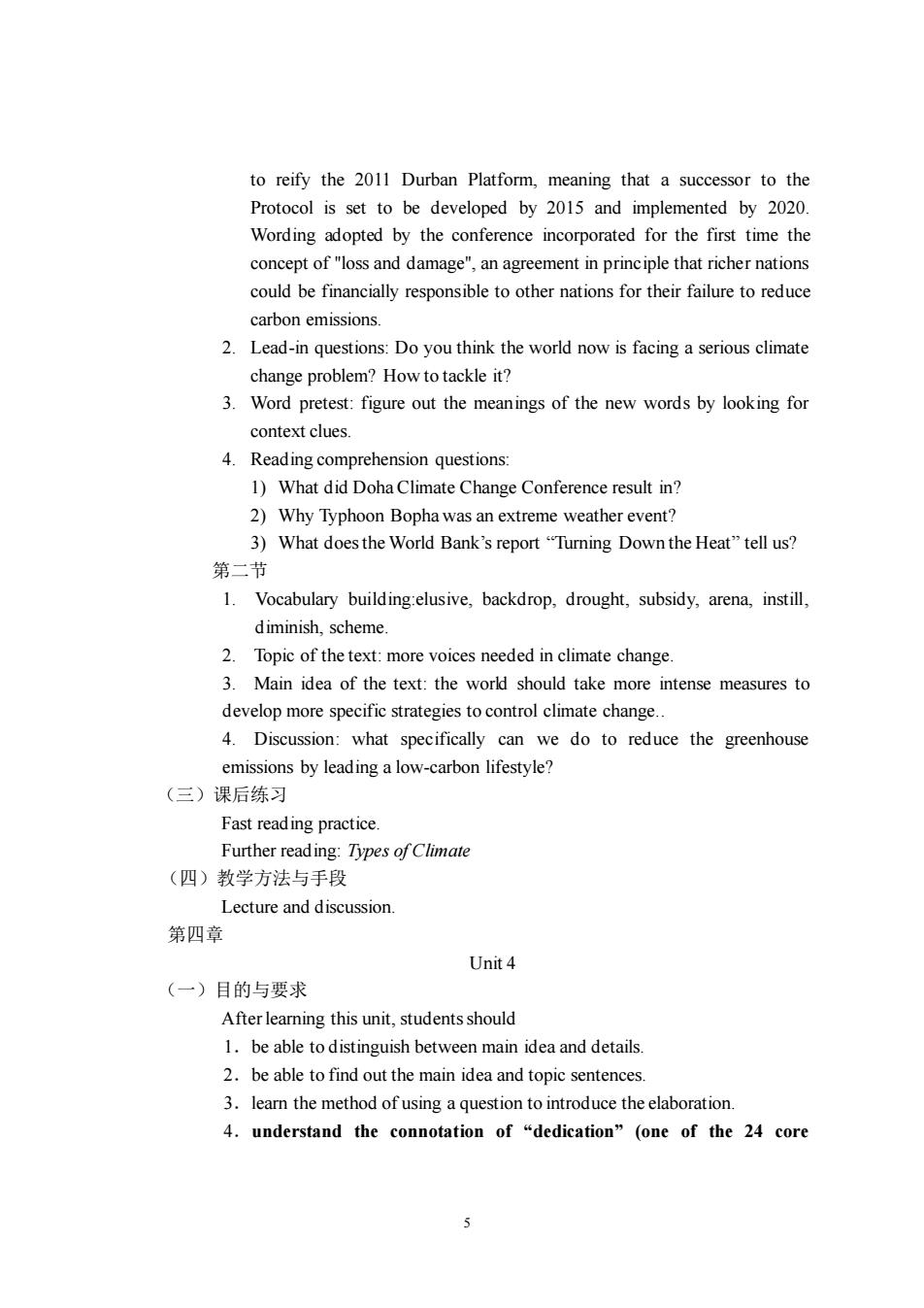
to reify the 2011 Durban Platform,meaning that a successor to the Protocol is set to be developed by 2015 and implemented by 2020 Wording adopted by the conference incorporated for the first time the concept of"loss and damage",an agreement in principle that richer nations could be financially responsible to other nations for their failure to reduce carbon emissions. 2.Lead-in questions:Do you think the world now is facing a serious climate change problem?How to tackle it? 3.Word pretest:figure out the meanings of the new words by looking for context clues. 4.Reading comprehension questions: 1)What did Doha Climate Change Conference result in? 2)Why Typhoon Bopha was an extreme weather event? 3)What does the World Bank's report "Tuming Down the Heat"tell us? 第二节 1.Vocabulary building:elusive,backdrop,drought,subsidy,arena,instill, diminish,scheme 2.Topic of the text:more voices needed in climate change. 3.Main idea of the text:the world should take more intense measures to develop more specific strategies to control climate change. 4.Discussion:what specifically can we do to reduce the greenhouse emissions by leading a low-carbon lifestyle? (三)课后练习 Fast read ing practice Further reading:Types ofClimate (四)教学方法与手段 Lecture and discussion 第四章 Unit4 (一)目的与要求 After learning this unit,students should 1.be able to distinguish between main idea and details. 2.be able to find out the main idea and topic sentences. 3.leam the method of using a question to introduce the elaboration. 4.understand the connotation of "dedication"(one of the 24 core 5
5 to reify the 2011 Durban Platform, meaning that a successor to the Protocol is set to be developed by 2015 and implemented by 2020. Wording adopted by the conference incorporated for the first time the concept of "loss and damage", an agreement in principle that richer nations could be financially responsible to other nations for their failure to reduce carbon emissions. 2. Lead-in questions: Do you think the world now is facing a serious climate change problem? How to tackle it? 3. Word pretest: figure out the meanings of the new words by looking for context clues. 4. Reading comprehension questions: 1) What did Doha Climate Change Conference result in? 2) Why Typhoon Bopha was an extreme weather event? 3) What does the World Bank’s report “Turning Down the Heat” tell us? 第二节 1. Vocabulary building:elusive, backdrop, drought, subsidy, arena, instill, diminish, scheme. 2. Topic of the text: more voices needed in climate change. 3. Main idea of the text: the world should take more intense measures to develop more specific strategies to control climate change.. 4. Discussion: what specifically can we do to reduce the greenhouse emissions by leading a low-carbon lifestyle? (三)课后练习 Fast reading practice. Further reading: Types of Climate (四)教学方法与手段 Lecture and discussion. 第四章 Unit 4 (一)目的与要求 After learning this unit, students should 1.be able to distinguish between main idea and details. 2.be able to find out the main idea and topic sentences. 3.learn the method of using a question to introduce the elaboration. 4.understand the connotation of “dedication” (one of the 24 core